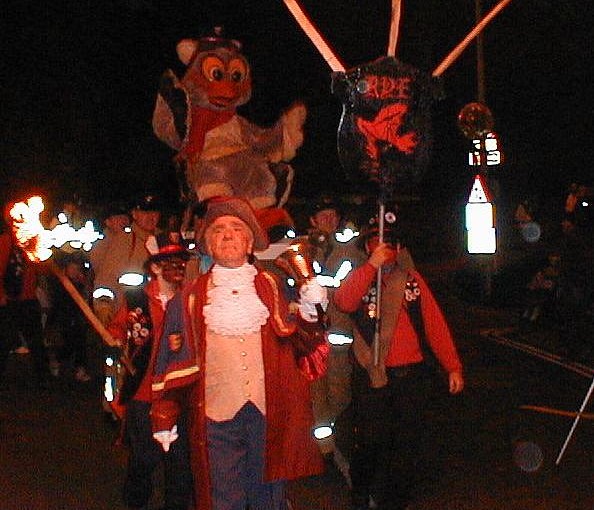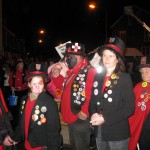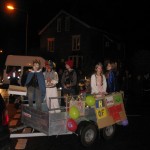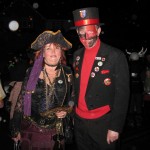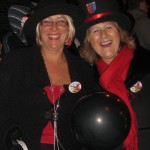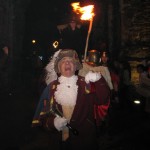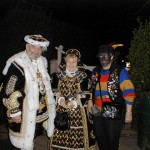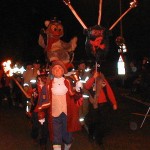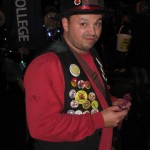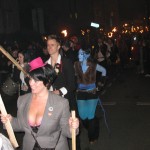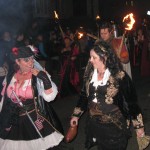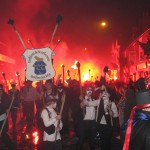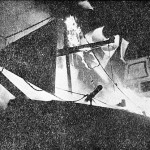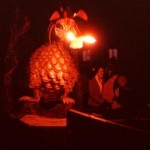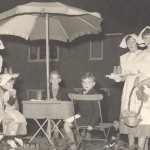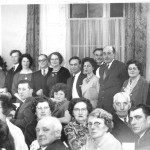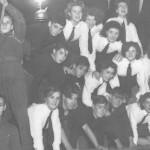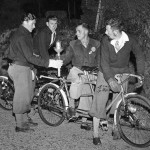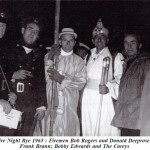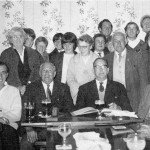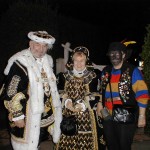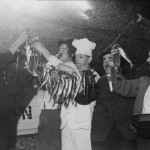By Jimper
Rye is famous for its bonfires on November 5th and our family have always been involved in the society. The faggots for the huge fire had to be got from the field where they had been used for the jumps at the local point-to-point and taken to the fire site on the salts at Rye, this was a job us young lads loved to do and dads lorry was kept busy Then the older boys and men would arrange them into a wonderful shape as a fire.
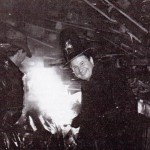
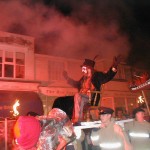
The fire in Rye is always lit by a well-known celebrity from films or TV, music etc. The guest is paraded through the town in a sedan chair on the shoulders of the fire brigade, to a procession of flaming torches onto the town’s salts to light the fire.
The night starts off at 6.30 with a fancy dress competition. Everyone dresses up in the most bizarre outfits. The Rye Bonfire Boys ask all the other societies and clubs in Rye along to the night. There are up to two thousand people, boys, girls, mums and dads, everyone in costume. Each club or society has a theme of dress; red Indians, smugglers, army, navy, ghost, monks, you name it, and they do it. The procession starts at 7.30 with a large maroon and then it is off.
With two thousand blazing torches burning, the host town leads off with bands, whistles and drums. At the end of this spectacular pageant were the tableaux and at the very end the town fire engine. Rye’s emblem is a burning boat, so a steel boat was placed on a trailer and a fire was lit in it.
Nowadays all the smoke and flames are created by lights. In the fifties and sixties, when I took part, nothing but the real thing did. We had an old steel lifeboat from a cross channel ferry on a large steel trailer and towed by a tractor. Three or four brave or foolish lads got aboard and up one end with old wood, car tyres and plenty of waste oil got a real blaze going. As we passed along the streets, the crowds had to stand back from the heat.
One year we came to a standstill, not for many minutes mind you, but long enough for the heat from the boat to blister all the paint on the building opposite. I have known the iron boat get red hot and glow.
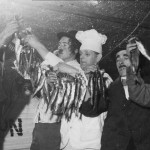
Another tradition was the bloater boat, a much more organised affair. Rye is famous for its bloaters to such an extent that when the Queen came to Rye one year, a local fisherman was asked to welcome Her Majesty to Rye by presenting her with a Sussex trug of bloaters. Three or four well known local characters would don white jackets and straw hats and ship aboard the bloater boat whose rigging was dressed with any flags that came to hand amid which sat a stuffed parrot. With all the new rules and regulations the serving of bloaters came to an end, the parrot found a new home on the shoulder of my pirates costume that I took all over Sussex collecting for charity. There they had a coke brazier and boxes of local fresh bloaters warmed at the local mill bakery in their bread ovens. An ample supply of bread and it was off to sell bloaters to the crowd. Woe betide anyone who was not familiar to the bloater for they are smoked herring with the head and guts in. Any complaints about bones, which they were served, were met by a crewmember throwing more bloaters at you than you can poke a stick at. The crowds loved it.
Rye also had a dragon, a huge beast, built on a trailer hidden in a cave with his head and neck sticking out the front. At the back he had a large tail that thrashed to and fro. His head was controlled like his tail, from inside the cave, where three men operated it. His nostrils used to be fired by oxyacetylene gas and the flames were three feet long.
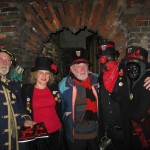
Sadly he is no more and a modern dragon has taken his place, just as handsome and made of metal scales, but the fire from his nose has been replaced by lights and chemical smoke.
The burning boats days were numbered with the introduction of plastic GPO wires. The whole town was wired up with it. The old phone cables were made of solid copper wire and could stand up to the flames making them hot. These new GPO cables used to burst into flames and melt. Also, the rules of the nation now state that to “subject its people to such terror and potential harm is unlawful”. What with the pollution from oil and burning rubber tyres, you can’t blame them.
The timely end came to the burning boat around midnight, far from Rye on a very cold and deserted road. We had been with it on a visit to another bonfire and being so cold we kept the fire well stoked. Aboard were eight of us huddled together in the bows?
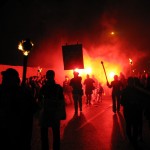
Frank was driving the tractor; we were going home. The trailer had no springs but we had acquired a red road works lamp on the way out and this swung at the back on a bit of wire. We were getting rid of all the wood, oil and tyres when suddenly we hit a bump in the road and everything went dark and cold. The bottom of the steel hull had had enough and had given up the ghost.
Behind us in the middle of the road lay strewn our lovely warm fire. We did no more than cheer and proceed on home. There was nothing else you could do.
A few months later, one of the crew gave birth to a fine boy, who is still a bonfire fanatic. Yes we were called Bonfire Boys although many girls do and did join the Society and good fun it is too. At all these events, a big thing is the charity collections, and many thousands of pounds each year are gathered in the tins and buckets to be distributed to local organisations.
After the fire has been lit there is a mighty firework display. Now professionals run it. In my young days we did it ourselves. I remember one year that we had something called a flying pigeon. It was a large rocket type firework that was supposed to travel along a tightly stretched wire for thirty yards, exploding in fantastic colours on its travel. Well this particular year it had its airs and refused to fly. I can now in my mind still see my cousin’s dad chasing it along that wire with a spade giving it such a wallop each time it jammed and the crowd roared with every swipe he took at that dreaded thing. Needless to say we never had another one of those. It would to take all day to erect the fireworks with all the static displays and we always ended up with one that said “Goodnight” in red and white. The rockets had to be all placed in racks and made ready before dark. The mortars were another kettle of fish. An eight-inch bomb had to slide neatly up a thick cardboard tube about four feet long to get airborne. It is a very powerful firework, so the tubes are buried in the ground with just the right slope on them to get them away from the crowd, and with luck they would attain six hundred to a thousand feet before they explode.
Nowadays some of the mortars at shows are twenty to thirty inches and fired in steel tubes. Ours were cardboard and all had to be in place well before dark with their fuses protruding from the tops. One year we dug them in and stamped the earth tight around the tubes, loaded them and waited for the off. The chairing of the celebrity to the fire site was our cue that the fire was about to be lit so we took our places.
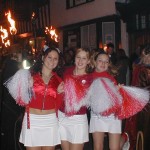
Now unknown to us, the earth was saturated with rain from the previous week and the cardboard tubes were swollen. I lit the first of the mortars and BANG! The whole lot, tube and all, shot out of the ground. The firework had failed to eject and go skywards. Instead it flew at me and hit me on my back, felling me face down in the mud and exploded four feet from the ground, cascading pretty colours into the crowd. My mate ran over to me and was amazed to find me very deaf, but alive. The crowds were showed with pieces of missile and cheered, all blissfully unaware that it had not been planned. Nowadays the display is half a mile away from the crowd and is all-aerial so everyone can see.
From Rye’s Own November 2008
“Rye’s Own” June 2015 Issue (Hard Copy Back Numbers Still Available) All articles, photographs, films and drawings on this web site are World Copyright Protected. No reproduction for publication without prior arrangement. © World Copyright 2015 Cinque Ports Magazines Rye Ltd., Guinea Hall Lodge Sellindge TN25 6EG
